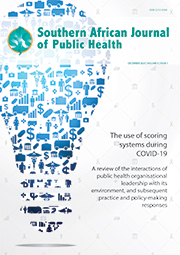Articles

Trajectory of fat-free mass and fat mass indices in small-for-date infants in India
Abstract
Background. Human growth during the first 2 years of life involves not only quantitative changes in body size, but also qualitative changes in body composition. Measuring fat-free mass (FFM) and fat mass (FM) in infants and children is of both scientific and public-health interest. The incidence of hypertension, type 2 diabetes and coronary heart disease is very high among south Asians compared with white people. In light of these findings, the measurement of body composition such as FFM and FM during the early development phase assumes importance.
Objectives. To establish the trajectories of the fat mass index (FMI), fat-free mass index (FFMI) and body mass index (BMI) of normalbirthweight (NBW) and low-birthweight (LBW) infants, and compare the age-related indices among NBW and LBW children.
Methods. This was a longitudinal study. A total of 240 NBW and LBW in six cohorts, aged 0, 45, 90, 180, 270 and 360 days at baseline, were enrolled from the neonatal care unit of a large charitable government hospital serving the urban poor population in the city of Kolkata, India. Weight and length (L) were measured, and total body water was determined by bio-electrical impedance analysis for estimation of FFM and FM. The indices FFM/L2 and FM/L2 were calculated, as were the indices FFM/LP and FM/LP, where p was selected in order to eliminate the correlation of these indices with length.
Results. The percentage of FFM gradually decreased in both NBW and LBW babies with an increase in age, and the percentage of FM gradually increased. The percentage of FFM in NBW babies was found to be lower than that in the LBW babies, and the percentage of FM in NBW babies was greater than in LBW babies.
Conclusion. The percentage of FM was consistently lower in LBW than the NBW infants. The fat percentage in all these infants was consistently lower, from birth to age 360 days, than in the reference data on healthy American infants in the West. BMI and FFMI gradually increased from 45 to 180 days of age, and then decreased up to 360 days. Similarly, FMI increased from 45 to 180 days of age, and from 180 to 270 days its growth remained constant. After that point, FMI gradually increased up to 360 days, but very slowly.
Authors' affiliations
B Sen, Health Research and Training Institute, Society for Applied Studies, Kolkata, India
A Sen, Health Research and Training Institute, Society for Applied Studies, Kolkata, India
D Mahalanabis, Health Research and Training Institute, Society for Applied Studies, Kolkata, India
Full Text
Cite this article
Article History
Date published: 2020-03-19
Article Views
Full text views: 1191

.jpg)


Comments on this article
*Read our policy for posting comments here